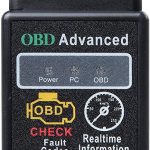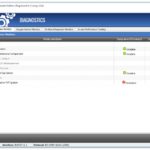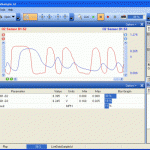Introduction to OBD2 Software
In the realm of automotive diagnostics and tuning, On-Board Diagnostics II (OBD2) software has emerged as an invaluable tool for BMW enthusiasts looking to enhance their vehicles. This specialized software allows drivers to tap into their BMW’s engine control unit (ECU) to not only diagnose issues but also to modify various coding functions.
The beauty of OBD2 software lies in its accessibility and versatility. With just a few clicks, users can unlock new features or customize existing ones, transforming their driving experience. Let’s say you own a BMW and love to personalize it. With the right OBD2 tool, you can activate features such as:
- Enhanced instrument cluster display
- Automatic window closing
- Adaptive headlight functions
Many BMW owners have shared how simple coding changes can significantly improve their daily driving experiences. For instance, a friend of mine recently used OBD2 software to enable a “digital speedometer” on his BMW. The transformation was not just aesthetic but provided valuable real-time information.
Significance of Coding Features in BMW
When discussing the significance of coding features in BMW vehicles, it’s essential to recognize the owner’s desire for personalization and performance. Unlike many other manufacturers, BMW allows for extensive coding modifications, supporting a culture of “tuning” among its enthusiasts. Here’s why this is important:
- Personalization: BMW owners often want their vehicles to reflect their unique styles. Customizable features such as lighting settings or user interface options allow for a tailored driving experience.
- Performance Enhancements: Beyond aesthetics, coding can also optimize performance by adjusting throttle response, shift points, and even suspension settings. For example, adjusting the ECU to better suit driving conditions can significantly improve handling.
- Future Upgrades: Using OBD2 software can prepare your BMW for future features and upgrades that weren’t initially available. This is particularly useful in keeping your vehicle contemporary with modern technology lacks that may arise.
- Cost Efficiency: Enabling features via software is often more economical than retrofitting or purchasing aftermarket parts. Small software updates can unlock significant functionalities without overwhelming costs.
The community surrounding BMW coding is vibrant, and as more enthusiasts discover OBD2 software, the potential for custom features and optimizations will continue to expand. Coding is not just a technical process; it’s a way to make the BMW truly your own while enhancing every aspect of the driving experience.
Retrofitting Functions for BMW Vehicles
Understanding Retrofitting in BMW
Continuing our exploration into the world of BMW coding, let’s delve into the intriguing realm of retrofitting. For BMW enthusiasts, retrofitting refers to upgrading a vehicle with new functionalities or equipment that may not have been part of the original factory design. This might include features such as advanced infotainment systems, upgraded lighting options, or even enhanced performance settings.
To provide a clear picture, consider this scenario: a BMW owner drives a model that came without adaptive cruise control. Through retrofitting, they can modify their vehicle to include this advanced feature, significantly enhancing their driving comfort and convenience during long journeys.
Retrofitting can be performed through various methods, but using OBD2 software stands out due to its accessibility and relative ease. Enthusiasts can utilize this software to enable hidden features within the ECU or even integrate new technologies seamlessly. In essence, retrofitting breathes new life into older BMW models, allowing them to keep pace with the latest trends and innovations.
Benefits of Retrofitting with OBD2 Software
The advantages of retrofitting with OBD2 software are substantial and often transformative for BMW owners. Here are some key benefits to consider:
- Enhanced Functionality: Retrofitting can transform a basic vehicle into a feature-rich machine. Imagine turning a standard dashboard into a fully digital interface featuring enhanced navigation, game-like graphics, or customizable displays.
- Cost-Effective Upgrades: Instead of investing in a brand-new model for fancy features, retrofitting with OBD2 software provides a budget-friendly alternative. Owners can unlock premium functionalities without incurring substantial costs.
- Increased Resale Value: Vehicles equipped with desirable features can command higher prices in the resale market. Retrofitting can help enhance a car’s value by equipping it with sought-after attributes.
- Personal Preference and Comfort: Retrofits allow drivers to tailor their vehicles to their unique preferences. For instance, customizing ambient lighting or enabling specific driving modes can significantly elevate the driving experience.
- Future-Proofing Your BMW: As technology continues to evolve, retrofitting can ensure your BMW remains competitive and equipped for upcoming innovations. This adaptability is vital in a fast-paced automotive landscape.
In conclusion, retrofitting not only extends the lifespan and capabilities of BMW vehicles but also enriches the ownership experience. With the help of OBD2 software, enthusiasts can readily unlock new potentials for their beloved BMWs, keeping them exciting and relevant for years to come.
Coding Capabilities for BMW Vehicles
Exploring Coding Options for BMW
Building upon the dynamic potential of retrofitting, let’s dive into the coding capabilities that BMW vehicles offer. When it comes to personalizing or optimizing a BMW, coding options stand out as one of the most flexible and rewarding routes.
Using OBD2 software, BMW owners can explore a myriad of coding options that can enhance both functionality and performance. Some popular coding features include:
- Daytime Running Lights (DRL): You can adjust your BMW’s DRL settings, optimizing them for better visibility while allowing you more control over when they operate.
- Digital Speed Display: Transform your analog speedometer into a digital display automatically, providing a more modern look and ease of reading.
- Automatically Folding Mirrors: Activate the feature for your side mirrors to fold in automatically when you lock the car, making parking in tight spaces much easier.
- Speed Limit Display: Enable the display of speed limit signs on the dashboard, helping you stay aware of local speed regulations effortlessly.
These coding options can profoundly enhance a vehicle’s functionality and create a more enjoyable driving experience. One of my friends took advantage of this feature to enable the “comfort access” option, allowing his BMW keys to unlock the doors with just a touch, no need to fumble around for keys. Once he experienced that convenience, he couldn’t imagine going back!
Customization Features with OBD2 Software
Customization features are a significant selling point for anyone looking to add a personal touch to their BMW. OBD2 software allows users to modify settings that cater not only to aesthetics but also driving preferences. Here are some key customization options:
- Interior Ambience Lighting: Personalize the color and intensity of your interior lighting to suit your mood or style—perfect for those night drives.
- Chirp Sound on Locking: Enable or disable the signature sound that confirms your BMW is locked, adding a nice auditory cue to your experience.
- Tailgate Opening Height: Modify how high your tailgate opens; a nifty feature especially handy for those parking in low-clearance areas.
- Seat Position Memory: Customize seat position settings to your unique preferences, allowing different drivers to adjust their seats effortlessly with the press of a button.
- Active Sound Design: Some enthusiasts enjoy enhancing the engine’s sound through the audio system, giving an invigorating auditory experience as they drive.
These customization features elevate your ownership experience, allowing BMW drivers to express their individuality. By using OBD2 software, it’s like giving your car a unique personality to match your own.
In summary, exploring coding options and customization features through OBD2 software presents exciting opportunities for BMW owners. Enhancing and personalizing vehicles not only improves functionality but also makes each journey that much more enjoyable.
Popular OBD2 Software Tools for BMW
Review of Top OBD2 Software for BMW Coding
As we transition to the tools that enable the magical coding and customization processes, it’s essential to highlight some of the most popular OBD2 software tools available for BMW vehicles. Each tool has its unique features, making them appealing to different user demographics—from beginners to seasoned enthusiasts.
- BMW Standard Tools (BST): This tool is often favored by professionals. It offers a comprehensive suite for diagnosing and coding BMWs, but it can be daunting for beginners. However, those willing to invest time will appreciate its depth.
- BimmerCode: BimmerCode has captured the hearts of amateur enthusiasts with its user-friendly interface. Users can easily code various functions simply through a mobile app, making it perfect for those who want to make quick adjustments on the go. Personally, I used BimmerCode to enable the “dark theme” feature on my friend’s 5 Series, and he was thrilled with the modern look it created.
- ESYS: Focused mainly on newer models, ESYS is powerful and allows advanced coding capabilities. It’s often used by professionals for complex modifications but requires familiarity with BMW’s coding structure.
- Inpa: INPA is primarily a diagnostic tool, yet it allows coding and programming capabilities for BMWs as well. It’s great for pinpointing issues while also offering some customization options.
- Carly for BMW: Carly is another mobile app that offers both diagnostics and coding functionalities. What sets it apart is its capability to read trouble codes and provide reports alongside coding options.
These tools each have their distinct strengths, providing BMW owners the flexibility to choose one that suits their practical needs and technical skill levels.
A Comparison of Features and Functions
When selecting an OBD2 software tool, understanding the features and functions they offer is crucial. Here’s a quick comparison of the tools mentioned above:
| Software | User-Friendliness | Diagnostic Capabilities | Coding Options | Advanced Features | ||||||||||||||||||||
|---|---|---|---|---|---|---|---|---|---|---|---|---|---|---|---|---|---|---|---|---|---|---|---|---|
| BMW Standard Tools (BST) | Medium | Excellent | Extensive | Comprehensive programming | BimmerCode | High | Basic | Wide | Mobile app convenience | ESYS | Low | Good | Extensive | Deep coding abilities | INPA | Medium | Excellent | Some | Diagnostic reporting | Carly for BMW | High | Good | Moderate | User-friendly interface |
As illustrated in the table, your choice might depend on whether you prioritize user-friendliness or require robust diagnostic capabilities. For a first-time coder, BimmerCode or Carly might be the best bet due to their intuitive designs. For seasoned experts looking to dig deeper, BMW Standard Tools or ESYS would provide the functionality they crave.
Ultimately, knowing your specific needs will guide you to the right OBD2 software tool, paving the way for an engaging and customized experience with your BMW!
Steps to Code Functions Using OBD2 Software
Preparing for Coding
Now that we’ve explored popular OBD2 software tools for BMW, it’s time to transition into the practical side of things—how to code those exciting features using the software. Preparation is key to ensuring a smooth coding experience and minimizing risks.
Before diving into the coding process, here are some critical preparatory steps to keep in mind:
- Gather the Necessary Tools: Make sure you have the right OBD2 software and a compatible OBD2 interface cable or dongle. Whether it’s BimmerCode or another software tool, each requires specific hardware, so verify compatibility.
- Fully Charge Your Battery: Coding can be taxing on your car’s battery. If it’s low, consider using a trickle charger to ensure you don’t end up in a situation where you lose power mid-coding.
- Backup Your Current Settings: Many coding software options will allow for backing up your current configuration. This step is crucial; it’s like having a safety net in case you need to revert to the original settings.
- Read the Vehicle Manual: Familiarize yourself with your BMW’s specific model information. Sometimes, certain features may vary across different models and years, helping you avoid mistakes during coding.
- Find a Quiet and Comfortable Workspace: Setting up in a distraction-free environment can help you focus, especially if you’re tackling complex codes or modifications.
With these preparation steps completed, you’ll be well-equipped to proceed with the coding process without any hitches.
Step-by-Step Coding Process for BMW
Now that you’re prepared, let’s break down the actual coding process into manageable steps:
- Connect the OBD2 Adapter: Plug the OBD2 adapter into your vehicle’s OBD2 port, typically located under the steering wheel. Your device should light up to indicate a successful connection.
- Launch the OBD2 Software: Open your chosen OBD2 software on your device. Make sure it’s properly paired with your OBD2 adapter.
- Select Your Vehicle Model: Follow the software prompts to input or select your BMW’s model and year. This ensures that you are working with the correct coding parameters.
- Access the Coding Menu: Navigate to the coding or customization menu of the software. This section typically outlines all the available functions that you can change or enable.
- Choose Desired Functions: Browse through the list of coding options and select the features you want to enable or modify. This could be anything from changing the lighting settings to enabling comfort access.
- Execute the Code Change: After selecting your desired options, follow the software’s prompts to write these changes to the vehicle’s ECU. Pay attention to any warnings that may arise.
- Confirm Changes and Test: Once the coding process is complete, it’s time to verify that the new features are functioning correctly. Take your vehicle for a quick drive to ensure everything works as intended.
- Backup Again (Optional): After successful coding, some software may allow you to create a new backup reflecting the updated settings for future reference.
By following these steps, you can confidently navigate the coding process and unlock new features in your BMW. With a little practice, coding will become second nature, and you’ll be well on your way to tailoring every aspect of your driving experience!
Troubleshooting and Tips for Successful Coding
Common Coding Issues and Solutions
As we delve deeper into the coding journey, it’s essential to address potential pitfalls that can arise during the coding process. Whether you’re a novice or an experienced coder, encountering issues can be a part of the experience. Understanding common coding problems and their solutions can save both time and frustration.
- Connection Errors: One of the most frequent issues occurs when the OBD2 adapter fails to connect with the vehicle correctly.
- Solution: Ensure that the adapter is well-connected to the OBD2 port, and confirm that your device is Bluetooth compatible (if using a wireless adapter). Restart both the software and the vehicle for a fresh connection.
- Power Issues: If your battery voltage drops too low during the coding process, it may result in incomplete programming.
- Solution: Always ensure your battery is fully charged before starting. For added safety, connect a trickle charger while coding.
- Error Codes: Occasionally, coding can lead to the appearance of error codes or warnings on the dashboard.
- Solution: Use the software to read the codes that appear. Address any underlying issues before proceeding with further coding. Backtracking to your original settings using the backup is also a viable option.
- Functionality Not Working as Expected: Sometimes, coded functions may not perform as anticipated or may not activate at all.
- Solution: Double-check the coding options you selected. It’s crucial to follow all instructions provided by the OBD2 software. Additionally, some functions may be model-specific—ensure they are compatible with your vehicle.
- Inconsistent Changes: If changes revert after restarting your vehicle, it hints at a problem with storing settings.
- Solution: Ensure you follow the correct save instructions within the software and create a fresh backup after changes.
Best Practices for Efficient Coding
To make your coding experience more efficient and successful, consider adopting a few best practices:
- Stay Organized: Document every change you make. Keeping track of what was altered will help if you need to troubleshoot or revert to previous settings.
- Use the Latest Software Version: Always keep your OBD2 software updated. New releases often include bug fixes and enhancements, improving performance and expanding coding options.
- Take Breaks Between Sessions: Don’t rush through coding. Take breaks to avoid fatigue, allowing you to think critically about the changes you’re making.
- Seek Community Support: Join online BMW forums or groups. Sharing your experiences with fellow enthusiasts can provide valuable insights into coding options and troubleshooting techniques.
- Test Incrementally: Instead of making several changes at once, code one function at a time. This method makes it easier to identify any issues that arise.
- Restoration Awareness: Familiarize yourself with restoring settings to factory defaults. Knowing how to revert coding changes can offer peace of mind, especially if you’re trying new functions.
By incorporating these practices and being aware of common issues, coding your BMW can be a more enjoyable experience rather than a source of frustration. Embrace the journey of customization, and soon enough, you’ll have a car tailored to your preferences and lifestyle!
Future Developments in OBD2 Software for BMW
Trends in BMW Coding Technology
As we glide into the future, it’s important to recognize the evolving landscape of automotive technology, specifically regarding OBD2 software for BMW vehicles. Recent trends indicate that coding technology is broaching new horizons, promising to revolutionize how enthusiasts engage with their cars.
- Increased Connectivity: The rise of smartphone applications is a game-changer for BMW owners. Tools like BimmerCode and Carly offer not only coding functionalities but also seamless connectivity. This trend will likely continue, integrating even more features into mobile platforms for ease of use.
- Cloud-Based Functionality: Imagine being able to store your coding backup in the cloud, accessible anytime, anywhere. This capability is becoming more prevalent, allowing users to sync their settings across devices and share them within the community.
- Real-Time Monitoring and Analytics: Future OBD2 software could leverage data analytics to provide real-time feedback on a vehicle’s performance. This would empower owners with insights into their driving habits, allowing for targeted coding adjustments to enhance efficiency and performance.
- Artificial Intelligence Integration: With ongoing advancements in AI, we may see OBD2 software equipped with AI-driven suggestions for coding modifications based on user preferences and driving history. Personalization of your BMW could become even more intuitive!
These trends not only enhance user experience but also promote a deeper connection between drivers and their vehicles. As these technologies evolve, BMW enthusiasts will benefit from unprecedented customization options.
Potential Advancements in OBD2 Software
While the future of OBD2 software for BMW looks promising, there are specific advancements we can anticipate:
- Enhanced User Interfaces: As software technology improves, we can expect more intuitive and visually engaging interfaces that make navigation through coding options easier even for beginners.
- Expanded Coding Libraries: New software updates could introduce additional coding options and features previously unavailable. This will empower users to unlock even more capabilities within their vehicles, enriching the overall driving experience.
- Improved Error Handling: Future OBD2 software may feature more sophisticated error handling mechanisms. This could include clear diagnostics along with suggested troubleshooting steps, taking the guesswork out of solving coding issues.
- Cross-Platform Compatibility: As technology converges, we might see OBD2 tools that are compatible across different car brands, not just BMW. This could foster a broader car enthusiast community, allowing users to share experiences and coding solutions.
- Integration with Smart Devices: Imagine controlling vehicle functions through devices like smartwatches or home assistants. Future OBD2 software might integrate directly with smart home technology, allowing for unique functionalities, such as starting your car or checking its status remotely.
In conclusion, the future of OBD2 software for BMW is on the brink of exciting advancements, creating new possibilities for automotive enthusiasts. As these trends and potential advancements unfold, expect coding to evolve from an essential skill to an engaging hobby that further enhances the joy of driving a BMW. Whether you’re looking to add new functions or fine-tune performance, the future promises to be rich with possibilities!
Conclusion and Considerations
Recap of Benefits of OBD2 Software
As we conclude our exploration into the world of OBD2 software and its applications for BMW vehicles, it’s essential to highlight the myriad benefits this technology brings to the table. Whether you’re a seasoned automotive enthusiast or just starting to dive into coding, the advantages are clear:
- Enhanced Customization: OBD2 software enables BMW owners to tailor their vehicles to meet their unique preferences. From adjusting lighting settings to enabling features like comfort access, the level of personalization available is impressive.
- Cost-Effective Enhancements: Rather than diving into expensive aftermarket modifications or purchasing newer models for additional features, OBD2 software provides budget-friendly alternatives to unlock new functionalities through coding.
- Fostering Community: Engaging with OBD2 coding often leads to connections with other enthusiasts. Online forums and communities foster an environment for sharing tips, troubleshooting issues, and celebrating successful modifications.
- Increased Resale Value: Vehicles equipped with desirable features often command higher resale prices. By utilizing OBD2 software to unlock premium options or improve overall functionality, owners can enhance their car’s market value.
- Simplified Troubleshooting: Diagnostic capabilities of OBD2 software allow owners to identify problems before they escalate, providing peace of mind that often leads to smoother driving experiences.
Reflecting on these benefits, it’s evident that OBD2 software is not just a luxury—it’s a tool that transforms the way enthusiasts interact with their BMWs.
Final Thoughts on BMW Coding and Retrofitting
As we wrap up our discussion on BMW coding and retrofitting, it’s vital to recognize that this journey is not just about technical modifications; it’s about optimizing the driving experience and creating a deeper connection between the driver and vehicle.
Much like a custom suit, every BMW can be tailored to fit the owner’s lifestyle and preferences perfectly. The ability to retro-fit features previously inaccessible or enable unique options through coding opens up endless possibilities for enhancement.
My own experiences with coding have led to some tangible improvements; for example, enabling the automatic folding mirrors has made parking in tight spots so much easier! Similarly, I’ve noticed how slight adjustments to throttle responsiveness have elevated the driving experience from simple commuting to sheer enjoyment.
However, responsible coding and retrofitting require careful consideration. Errors can lead to unintended consequences, and it’s always wise to proceed with caution, keeping backups and ensuring that you stay informed about best practices.
As advancements in OBD2 software continue to evolve, BMW enthusiasts can look forward to new opportunities for customization, convenience, and a truly unique driving experience. Whether you’re just beginning or planning to explore deeper into the capabilities of your vehicle, the world of coding and retrofitting is ready to welcome you. So gear up, dive in, and enjoy the ride!





